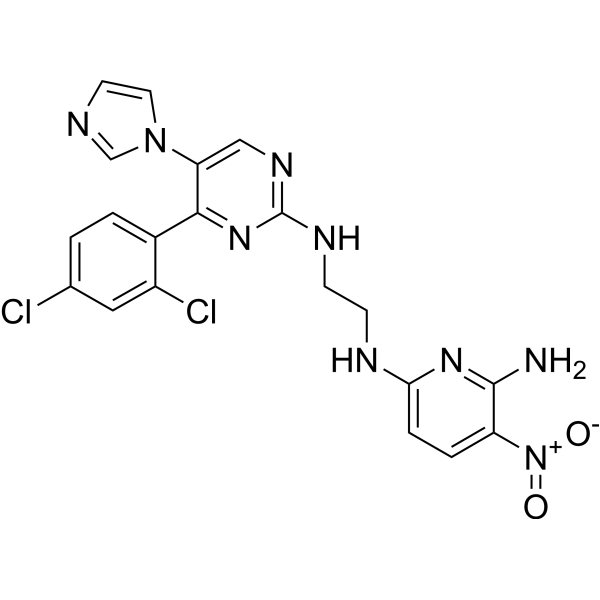Home
Products
CHIR-98014



| Product Name | CHIR-98014 |
| Price: | Inquiry |
| Catalog No.: | CN00250 |
| CAS No.: | 252935-94-7 |
| Molecular Formula: | C20H17Cl2N9O2 |
| Molecular Weight: | 486.31 g/mol |
| Purity: | >=98% |
| Type of Compound: | Alkaloids |
| Physical Desc.: | Powder |
| Source: | |
| Solvent: | Chloroform, Dichloromethane, Ethyl Acetate, DMSO, Acetone, etc. |
| SMILES: | Clc1ccc(c(c1)Cl)c1nc(NCCNc2ccc(c(n2)N)[N+](=O)[O-])ncc1n1cncc1 |
| Contact us | |
|---|---|
| First Name: | |
| Last Name: | |
| E-mail: | |
| Question: | |
| Description | CHIR-98014 is a potent, cell-permeable GSK-3 inhibitor with IC50s of 0.65 and 0.58 nM for GSK-3α and GSK-3β, respectively; it shows less potent activities against cdc2 and erk2. |
| Target | GSK-3β:0.58 nM (IC50) GSK-3α:0.65 nM (IC50) cdc2:3700 nM (IC50) |
| In Vitro | CHIR 98014 inhibits human GSK-3β with Ki value of 0.87 nM. CHIR 98014 causes GS stimulation in CHO-IR cells and rat hepatocytes, with EC50s of 106 nM and 107 nM, respectively[1]. CHIR-98014 (1 μM) reduces the viability of ES-CCE cells by 52%, with IC50 of 1.1 μM. Moreover, CHIR-98014 in combination with CHIR-99021 results in a significant activation of the Wnt/beta-catenin pathway in ES-D3 cells. In CHIR-98014 treated cells, the T gene expression is induced up to 2,500-fold. CHIR-98014 (1 μM) also yields around 50% Brachyury-positive cells, with EC50 of 0.32 μM[2]. CHIR98014 (10 μM) prevents loss of neurites caused by 20 μM PrP1-30 in cortical and hippocampal neurons, and substantially decreases the amount of dead cells[3]. |
| In Vivo | CHIR 98014 (30 mg/kg, i.p.) exhibits a significant reduction in fasting hyperglycemia within 4 h of treatment and shows improved glucose disposal during an ipGTT in markedly diabetic and insulin-resistant db/db mice[1]. |
| Cell Assay | The viability of the mouse ES cells is determined after exposure to different concentrations of GSK3 inhibitors for three days using the MTT assay. The decrease of MTT activity is a reliable metabolism-based test for quantifying cell viability; this decrease correlates with the loss of cell viability. 2,000 cells are seeded overnight on gelatine-coated 96-well plates in LIF-containing ES cell medium. On the next day the medium is changed to medium devoid of LIF and with reduced serum and supplemented with 0.1-1 μM BIO, or 1-10 μM SB-216763, CHIR-99021 or CHIR-98014. Basal medium without GSK3 inhibitors or DMSO is used as control. All tested conditions are analyzed in triplicates[2]. |
| Animal Admin | Blood is obtained by shallow tail snipping at lidocaine-anesthetized tips. Blood glucose is measured directly or heparinized plasma is collected for measurement of glucose or insulin. Animals are prebled and randomized to vehicle control or GSK-3 inhibitor treatment groups. For glucose tolerance tests (GTTs), animals are fasted throughout the procedure with food removal early in the morning, 3 h before first prebleed (db/db mice), or the previous night, 16 h before the bleed (ZDF rats). When the time course of plasma glucose and insulin changes in fasting ZDF rats is measured, food is removed ∼16 h before test agent administration. The glucose challenges in the GTT are 1.35 g/kg i.p. (ipGTT) or 2 g/kg via oral gavage (oGTT). Test inhibitors are formulated as solutions in 20 mM citrate-buffered 15% Captisol or as fine suspensions in 0.5% carboxymethylcellulose[1]. |
| Density | 1.6±0.1 g/cm3 |
| Boiling Point | 839.0±75.0 °C at 760 mmHg |
| Flash Point | 461.2±37.1 °C |
| Exact Mass | 485.088226 |
| PSA | 158.85000 |
| LogP | 3.76 |
| Vapour Pressure | 0.0±3.1 mmHg at 25°C |
| Storage condition | -20℃ |